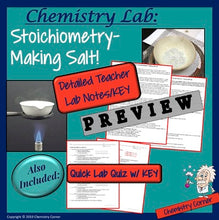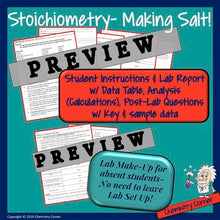This is a great lab to end your stoichiometry unit. Students will perform a reaction, convert grams to moles, identify the limiting and excess reactant, calculate their actual yield, calculate the theoretical yield, and finally calculate their percent yield.
I love this lab for several reasons. One reason is that the percent yield is usually very high for students. You may even have some students get a 100% yield! Another reason I love this lab is that it is very easy to set up, and for students to run—so I can use it for standard chemistry students as well as advanced chemistry students. Finally, this lab presents so many teachable moments opportunities that really allow students to deepen their understand of stoichiometry, percent yield, and limiting & excess reactants.
Objectives:
Convert grams to moles.
Distinguish between theoretical yield, actual yield, and percentage yield.
Calculate actual yield and theoretical yield for a chemical reaction performed in the lab.
Calculate the percentage yield for a chemical reaction performed in the lab.
NGSS:
HS-PS1-7: Use mathematical representations to support the claim that atoms, and therefore mass, are conserved during a chemical reaction.
DCI: PS1B: The fact that atoms are conserved, together with knowledge of the chemical properties of the elements involved, can be used to describe and predict chemical reactions.
Science & Engineering Practices—Using Mathematics and Computational Thinking: Use mathematical representations of phenomena to support claims.
Cross-Cutting Concepts—Energy & Matter: The total amount of energy and matter in closed systems is conserved.
Prior Knowledge for Students:
Students should be able to write and balance chemical equations, convert mass to moles, set up basic stoichiometry equations, identify the limiting and excess reactants, calculate percent yield, and determine the amount of left over excess reactant.
Teacher Prep Time: below average
Included in this Lab:
Student directions
Teacher Notes—detailed
Student Lab Report w/sample data key
Lab Quiz w/ Key
Lab Makeup w/ Key
Materials Needed for this Lab: basic lab equipment, and no difficult solutions to prepare
This lab is appropriate for grades 9-12 chemistry.
Lab Duration: You should be able to complete the lab in one class period-with a pre-lab session the day before. I have discussed some ways to conduct the lab, depending on the level of your students, in the teacher notes.
You will want to save this lab and use it for years to come!
Chemistry Corner
**************************************************************************************
Check out these other products that you may be interested in:
High School Chemistry Year Curriculum
Stoichiometry: A Complete Lesson
Stoichiometry: Percent Yield
Stoichiometry: Limiting & Excess Reactants
*************************************************************************************
LICENSING TERMS: By purchasing this product, you own a license for one teacher only for personal use in your classroom. Licenses are non-transferable, meaning they cannot be passed from one teacher to another. No part of this resource is to be shared with colleagues or used by an entire grade level, school, or district without purchasing the proper number of licenses. I you are a coach, principal or district interested in transferable licenses to accommodate yearly staff changes, please contact beth@chemistrycorner.com.
COPYRIGHT TERMS: ©Chemistry Corner. Please note – all material included in this resource belongs to Chemistry Corner. By purchasing, you have a license to use the material, but you do not own the material. This resource, or any portion of this resource, may not be uploaded to the internet in any form, including classroom/personal websites or network drives, unless the site is password protected and can only be accessed by students—no other teachers or anyone else on the internet.






